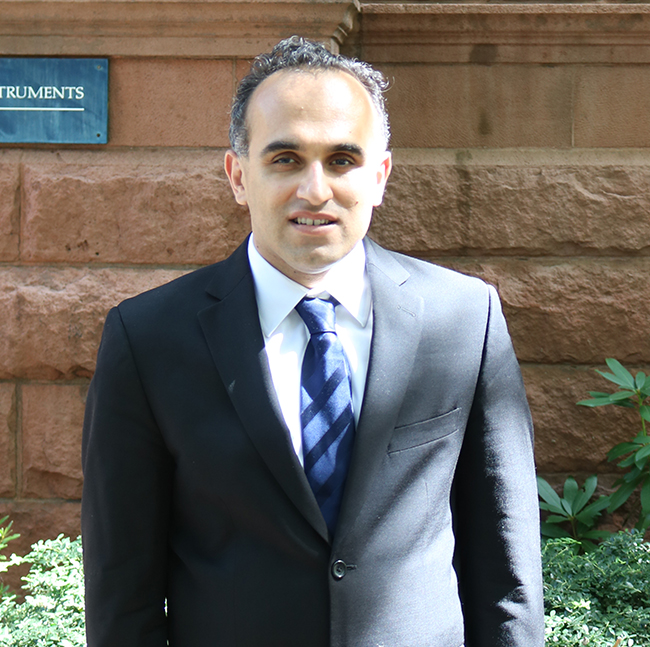Shreya Saxena and Amir Haji-Akbari Named Sloan Fellows

For pioneering research in their respective fields, professors Shreya Saxena and Amir Haji-Akbari have been named 2025 Sloan Research Fellows.
Awarded by the Alfred P. Sloan Foundation, the Sloan Research Fellowship Program honors exceptional early career researchers whose “creativity, innovation, and research accomplishments make them stand out as the next generation of leaders.” The two-year, $75,000 fellowships are awarded annually to researchers in the U.S. and Canada.
 Saxena, assistant professor of biomedical engineering, uses computational methods to understand and predict the relationship between neural activity and behavior. She leads a collaborative and data-driven lab that focuses on the intersection between neuroscience, artificial intelligence, and control theory, which involves how the many components of the brain work together to achieve a desired result through our bodies. Her research includes computational modeling of the neural circuits behind sensorimotor control, decision-making, and learning multiple tasks.
Saxena, assistant professor of biomedical engineering, uses computational methods to understand and predict the relationship between neural activity and behavior. She leads a collaborative and data-driven lab that focuses on the intersection between neuroscience, artificial intelligence, and control theory, which involves how the many components of the brain work together to achieve a desired result through our bodies. Her research includes computational modeling of the neural circuits behind sensorimotor control, decision-making, and learning multiple tasks.
Much of her work involves creating computer models of the brain’s workings, with applications in decision-making, social behavior, and sensorimotor control (how your brain combines motor commands with sensory information to get your body to move). Saxena has developed algorithms for the joint analysis of neural and behavioral data to address the overarching question: how do populations of neurons act in a coordinated fashion to generate behavior?
In one pioneering project, Saxena’s lab uses anatomically accurate models of monkey and mouse musculoskeletal dynamics, and applies deep reinforcement learning to train recurrent neural networks to achieve specific goals.
Saxena created µSim, a computational framework that models the motor cortex, the part of the brain most responsible for movement. More than other computational models, the sophisticated framework can capture the complexity that goes into realizing movements. This allows it to analyze and predict novel limb movements, as well as the corresponding neural activity that leads to the movements. That makes it extremely valuable for such applications as a brain-controlled prosthetic limb.
Yale Engineering Dean Jeffrey Brock said Saxena is using artificial intelligence and other technologies to give us a clearer picture of how the brain affects how we move and behave.
“The Sloan Fellowship is a well-deserved honor for Shreya, whose research stretches across several disciplines to give us an unprecedented understanding of the intricacies of the brain,” Brock said. “Studying the neural phenomena that underlie motor control is a complex and challenging problem, and Shreya’s approach, using constraints-based modeling, is yielding promising results. It’s this kind of exploratory work that promises to allow researchers to ‘reverse-engineer’ how the brain drives movement — with implications for treating neurological disorders, healing paralysis, creating advanced prosthetics, and ultimately providing insight into the nature of consciousness itself."
 Haji-Akbari, associate professor of chemical & environmental engineering, focuses on using tools from thermodynamics and statistical physics to understand phase transitions in nature. These include a wide range of systems, such as ice formation in the atmosphere, ion transport through synthetic and biological channels, protein folding and aggregation, and colloidal crystallization.
Haji-Akbari, associate professor of chemical & environmental engineering, focuses on using tools from thermodynamics and statistical physics to understand phase transitions in nature. These include a wide range of systems, such as ice formation in the atmosphere, ion transport through synthetic and biological channels, protein folding and aggregation, and colloidal crystallization.
In one line of research, Haji-Akbari is developing advanced computational techniques to better understand heterogeneous crystal nucleation and to leverage that knowledge to exert increased control over crystal texture. One application is to devise better processes for making single crystalline materials, which are in high demand in a number of industries. Due to their superior transport properties, single crystalline materials are very useful for a variety of applications in electronics, solar energy conversion and aerospace industries.
For another project, he is studying ice nucleation in clouds – that is, the moment when water molecules first cluster up to form ice. To observe ice nucleation close to vapor-liquid interfaces, Haji-Akbari used computer simulations to calculate ice nucleation rates in a water nanofilm and see how they vary in comparison to the nucleation rate in the bulk, or the main body, at the same thermodynamic conditions. A better understanding of this process could lead to better climate prediction tools, and materials that both promote and prevent freezing.
His group has also been investigating several other rare events, such as the transport of ions through synthetic nanopores and biological channel proteins, as well as the kinetics and mechanism of protein folding and aggregation.
“By applying chemistry-based solutions to environmental problems, Amir is finding ways to combat climate change, increase the world supply of clean drinking water, and take on many other of our most crucial global challenges,” Brock said. “His work with nanoporous membranes is just one example of the way in which advanced computer modeling can overturn long-established assumptions. Amir’s unique model-driven approach enables him to use high-power simulations to bring new insights to some of the most pressing problems we face today."

